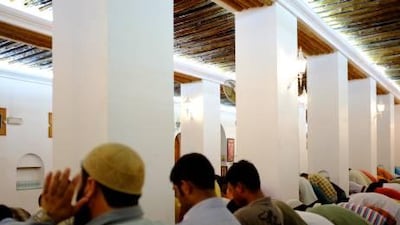RAS AL KHAIMAH // The blast of cannon in 1961 marked a new life for Fatema Saif Al Zaabi.
For six months the newlywed, aged 17, had looked on the imposing stone mosque outside her house, waiting for Ramadan to finally see its interior.
Cannon fire signalled the start of the holy month, the only time when women were allowed inside the great mosque for taraweeh and isha prayers.
"For us women it was in Ramadan and Ramadan only," Ms Al Zaabi says. "Not at other times. In Ramadan there were lots of women and men at night."
Half a century has passed since she arrived at the neighbourhood as a teenage bride but her Ramadan traditions and beloved mosque are much unchanged.
As with many residents, she simply calls the mosque "the old mosque" or "the big mosque".
They are fitting names. Residents and archaeologists agree the structure is probably 100 years old but archaeologists suspect the remains of a 15th century mosque may lie beneath it.
If so, the original mosque was built there when the area was the capital of the Qawassim empire, known from China to Portugal as a major maritime trade centre.
The Qawassim moved their capital to Sharjah after the British attacks of 1819, but their love of this neighbourhood endured and the Royal Family of RAK built their houses in the quarter that surrounds the mosque.
Homes belonged to royalty including the late Ruler of RAK Sheikh Saqr, his brother Sheikh Kayed, and their father Sheikh Mohammed bin Salim, for whom the mosque is named.
Of all these buildings, residents say only the old mosque still stands.
"Big sheikhs and ordinary people, all were inside," Ms Al Zaabi says. "Anyone could come. Whoever is here when its adhen time, they go."
Sheikh Mohammed, who was known for his generosity to the needy after the collapse of the pearling trade, would no doubt be pleased with the iftars served at the mosque today.
Sheikh Ali, the mosque's Egyptian imam for 18 years, supervises these iftars, keeping volunteers and workers relaxed and calm before iftar. His twin sons Hassan and Hussein, 10, are always seen around the mosque.
The mosque is on a hill between the turquoise Gulf and the creekside markets.
When Fatema visited the mosque in 1961 she entered a hall of 60 pillars, arched doorways and palm frond mats.
The mosque had its first major renovations in 1951 when Sheikh Saqr ordered that everyone give three rupees for its repairs.
Traders imported stone from the Tunb islands and wood from Zanzibar for its construction. Water for ablutions came from a well near the mosque. A covered walkway, patio, stonework and an additional 28 windows were added by the RAK Government in 1990.
It is considered the biggest and oldest mosque that is still in use in RAK.
"Every Friday when the men would go to prayer, women would clean in front of their houses," said Ms Al Zaabi. "All the men were at the mosque so the street could be cleaned up."
Women also cleaned the mosque exterior in secret at night.
Ms Al Zaabi's daughter Asmara remembers sitting with her mother in the mosque at the age of 4, trying her best to be quiet and not get in trouble. Asmara joined her mother in prayer at the age of 6.
Now 48, she visits the mosque with her mother and her own daughter, Amna.
"Each grandmother and mother gets their daughters around them and we go," said Asmara.
"We have our memories here and we were raised here. We have the souq, the sea, the mosque. This was Ras Al Khaimah."

